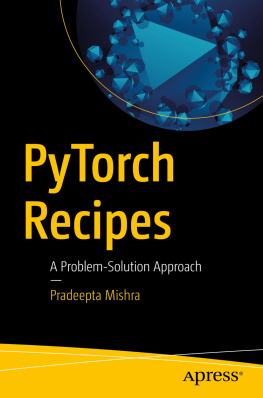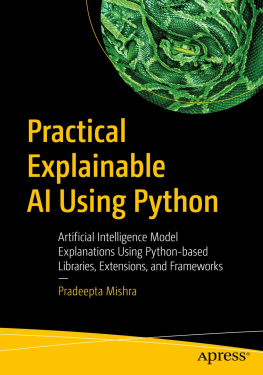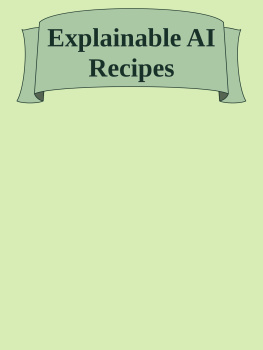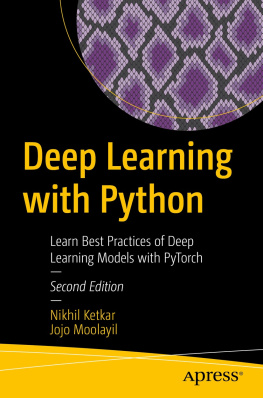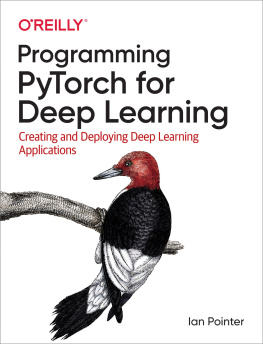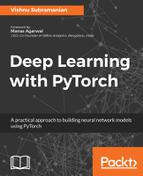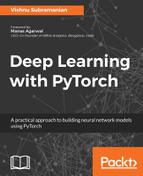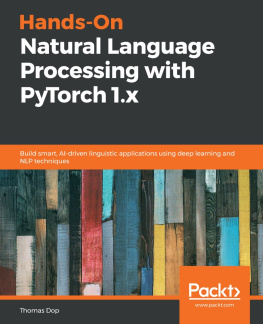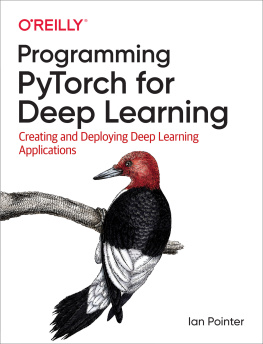Pradeepta Mishra
PyTorch Recipes A Problem-Solution Approach
Pradeepta Mishra
Bangalore, Karnataka, India
Any source code or other supplementary material referenced by the author in this book is available to readers on GitHub via the books product page, located at www.apress.com/978-1-4842-4257-5 . For more detailed information, please visit http://www.apress.com/source-code .
ISBN 978-1-4842-4257-5 e-ISBN 978-1-4842-4258-2
https://doi.org/10.1007/978-1-4842-4258-2
Library of Congress Control Number: 2018968538
Pradeepta Mishra 2019
Apress Standard
Trademarked names, logos, and images may appear in this book. Rather than use a trademark symbol with every occurrence of a trademarked name, logo, or image we use the names, logos, and images only in an editorial fashion and to the benefit of the trademark owner, with no intention of infringement of the trademark. The use in this publication of trade names, trademarks, service marks, and similar terms, even if they are not identified as such, is not to be taken as an expression of opinion as to whether or not they are subject to proprietary rights.
While the advice and information in this book are believed to be true and accurate at the date of publication, neither the authors nor the editors nor the publisher can accept any legal responsibility for any errors or omissions that may be made. The publisher makes no warranty, express or implied, with respect to the material contained herein.
Distributed to the book trade worldwide by Springer Science+Business Media New York, 233 Spring Street, 6th Floor, New York, NY 10013. Phone 1-800-SPRINGER, fax (201) 348-4505, e-mail orders-ny@springer-sbm.com, or visit www.springeronline.com. Apress Media, LLC is a California LLC and the sole member (owner) is Springer Science + Business Media Finance Inc (SSBM Finance Inc). SSBM Finance Inc is a Delaware corporation.
I would like to dedicate this book to my dear parents, my lovely wife, Prajna, and my daughter, Priyanshi (Aarya). This work would not have been possible without their inspiration, support, and encouragement.
Introduction
Development of artificial intelligent products and solutions has recently become a norm; hence, the demand for graph theorybased computational frameworks is on the rise. Making the deep learning models work in real-life applications is possible when the modeling framework is dynamic, flexible, and adaptable to other frameworks.
PyTorch is a recent entrant to the league of graph computation tools/programming languages. Addressing the limitations of previous frameworks, PyTorch promises a better user experience in the deployment of deep learning models, and the creation of advanced models using a combination of convolutional neural networks, recurrent neural networks, LSTMs, and deep neural networks.
PyTorch was created by Facebooks Artificial Intelligence Research division, which seeks to make the model development process simple, straightforward, and dynamic, so that developers do not have to worry about declaring objects before compiling and executing the model. It is based on the Torch framework and is an extension of Python.
This book is intended for data scientists, natural language processing engineers, artificial intelligence solution developers, existing practitioners working on graph computation frameworks, and researchers of graph theory. This book will get you started with understanding tensor basics, computation, performing arithmetic-based operations, matrix algebra, and statistical distribution-based operations using the PyTorch framework.
Chapters provide detailed descriptions on neural network basics. Advanced neural networks, such as convolutional neural networks, recurrent neural networks, and LSTMs are explored. Readers will be able to implement these models using PyTorch functions.
Chapters discuss fine-tuning the models, hyper parameter tuning, and the refinement of existing PyTorch models in production. Readers learn how to choose the hyper parameters to fine-tune the model.
In Chapter , natural language processing is explained. The deep learning models and their applications in natural language processing and artificial intelligence is one of the most demanding skill sets in the industry. Readers will be able to benchmark the execution and performance of PyTorch implementation in deep learning models to execute and process natural language. They will be able to compare PyTorch with other graph computationbased deep learning programming tools.
Acknowledgments
I would like to thank my wife, Prajna, for her continuous inspiration and support, and sacrificing her weekends just to sit alongside me to help me in completing the book; my daughter, Aarya, for being patient all through my writing time; my father, for his eagerness to know how many chapters I had completed.
A big thank you to Nikhil, Celestin, and Divya, for fast-tracking the whole process and helping me and guiding me in the right direction.
I would like to thank my bosses, Ashish and Saty, for always being supportive of my initiatives in the AI and ML journey, and their continuous motivation and inspiration in writing in the AI space.
Table of Contents
About the Author and About the Technical Reviewer
About the Author
Pradeepta Mishra
is a data scientist and artificial intelligence architect. He currently heads NLP, ML, and AI initiatives at Lymbyc, a leading-edge innovator in AI and machine learning based out of Bangalore, India. He has expertise in designing artificial intelligence systems for performing tasks such as understanding natural language and recommendations based on natural language processing. He has filed three patents as an inventor and has authored and co-authored two books: R Data Mining Blueprints (Packt Publishing, 2016) and R: Mining Spatial, Text, Web, and Social Media Data (Packt Publishing, 2017). There are two courses available on Udemy based on these books.
Pradeepta presented a keynote talk on the application of bidirectional LSTM for time series forecasting at the 2018 Global Data Science Conference 2018. He delivered a TEDx talk titled Can Machines Think?, a session on the power of artificial intelligence in transforming industries and changing job roles across industries. He has also delivered more than 150 tech talks on data science, machine learning, and artificial intelligence at various meetups, technical institutions, universities, and community forums.
He is on LinkedIn at www.linkedin.com/in/pradeepta/ .
About the Technical Reviewer
Shivendra Upadhyay
has more than eight years of experience working for consulting and software firms. He has worked in data science with KPMG for more than three years, and has a firm grasp of machine learning and data science tools and technologies.

